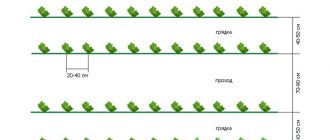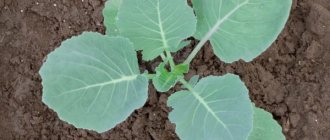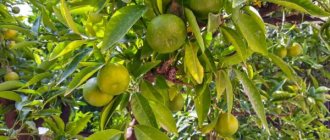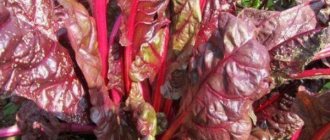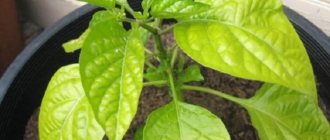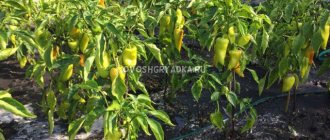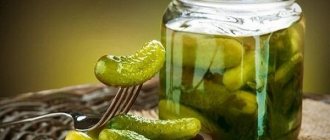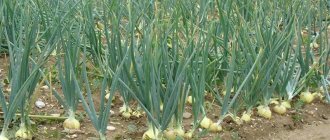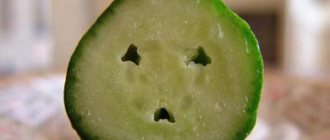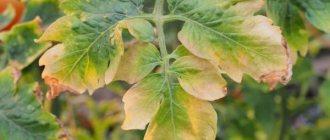» Vegetable growing » Cucumbers » Why do the leaves on cucumbers turn pale
0
2885
Article rating
Pale leaves on cucumbers are a sign of a lack of nutrients or, conversely, the result of overfeeding with any component. Other reasons include diseases and incorrectly selected agricultural technology. This can be corrected if a negative impact factor is identified in a timely manner and action is taken.
- Priority measures
- Fertilizer application technology
- Nitrogen-potassium
- Mineral
- Preventive measures
Why do the leaves on cucumbers turn pale?
Reasons for changes in leaf color
Everyone knows that nitrogen is responsible for the accumulation of greens in leaves. Its deficiency can lead to discoloration, that is, the leaves begin to turn pale.
Also, if the plant has weak roots, the result may be that the plant does not receive nutrients. Roots may not develop because alkaline reactions occur in the soil.
Now let’s take a closer look at why cucumber leaves are pale. To reproduce, cucumbers require a series of chemical reactions. Also, the foliage turns yellow unevenly when starvation occurs.
If there is not enough phosphorus, then naturally nitrogen will not be absorbed, which means the leaves will be pale, therefore, such a plant should be fed with nitrogen and phosphorus.
Causes of pale leaves and seedlings
What causes foliage to change color to light green? Do they differ in vines growing in greenhouses from those grown in open ground?
In the open ground
If you rush to plant cucumber seedlings in open ground, when the soil has not yet warmed up enough, the leaves may lighten and fall off. To eliminate the problem, a portable greenhouse is made - the temporary frame is covered with film. Leave it until the ground warms up.
In the greenhouse
Cucumber seedlings planted in a greenhouse may become sick, turn pale and dry out if disease spores were contained in untreated soil. Therefore, it is recommended to disinfect the soil, the greenhouse itself and gardening tools in advance.
How to deal with it
The lack of nutrients negatively affects the future harvest of cucumbers. In this article we will look at the reaction of cucumber to a lack of nutrients. And it’s natural how to deal with it.
If you find such a problem in your beds, then immediately prepare a solution with a weak content of the necessary elements.
Most often, this problem occurs in soil where there is little humus. To achieve a good result, you need to spray the leaves with the desired solution.
How to feed a diseased plant
You see that the leaves of cucumbers are light green; they should be immediately fed with nitrogen fertilizers. Since the lack of this substance first affects the leaves themselves, then they appear on young trunks, as a result the plant may die.
- Killing flies
Succinic acid for tomatoes and cucumbers: tips for use and choice of dosage for indoor, greenhouse and open-ground plants (80 photos)
How to save tomatoes from frost - ways to protect seedlings and greenhouse plants. Review of the best ideas, advice from gardeners (80 photos)
If the foliage becomes light, then you must immediately feed the plant with a manganese solution. This process can begin with the middle leaves. This means that the plant does not have enough copper.
Why do cucumber leaves turn pale?
The main reason for pale foliage in cucumbers is a lack or, on the contrary, an excess of certain micro- and macroelements. In most cases, an imbalance of nutrients entails a deterioration in the growth and presentation of cucumbers, but after taking appropriate measures, the fruiting of damaged bushes is completely restored.
The blanching of cucumber leaves occurs when there is a lack of the following elements:
- Nitrogen. The deficiency of this substance is reflected in the development of seedlings and modification of all elements of the tops - weak formation of lateral shoots and leaves, falling of inflorescences without the formation of green ovaries, but the most significant point is the spread of yellowness on mature leaves of seedlings. If you do not apply nitrogen fertilizing in a timely manner, the top leaves begin to turn yellow and, last of all, those that are located above the first two shoots. The lack of nitrogen in cucumber seedlings can be differentiated by the peculiar pattern of pale yellowness covering the leaves - the veins remain green until the last moment and lose color before falling off.
- A decrease in photosynthetic activity due to iron deficiency is immediately detected in the form of a loss of green color in young plants. Further inaction is reflected in the appearance of a dry edge along the perimeter of the damaged leaves, and the “washing out” of the intense green color transfers to mature leaves. The yield of cucumbers does not suffer from iron deficiency.
- Calcium. Already formed leaves almost do not react to a lack of calcium, but young leaves that are released turn out to be very small and have an unnaturally dark shade of green. After a short time, the new leaves begin to lose color along the edges and from the center. The pallor spreads in stripes over the surface of the leaf, without affecting the veins, then these areas die off, and the damaged edges bend downwards.
- Light green and then almost colorless tops of the leaves, with parallel wilting of the entire plant, indicate a lack of copper.
- The fact that the leaves on the plant first began to turn yellow, and then acquire a brownish tint and shrink, will indicate a potassium deficiency. The presence of a large amount of peat in the soil composition will aggravate the progression of leaf damage due to potassium deficiency.
- Phosphorus starvation stops the growth of a cucumber bush - the vine stops stretching upward, and the leaves on it become small and hard, as if leathery. Soon the modified leaves become covered with pale green spots, similar to water stains, and fall off.
If the gardener is overly enthusiastic about boron-containing fertilizers, he or she runs the risk of causing irreversible changes in the plantings and the destruction of the entire crop. The first sign that you should immediately stop using boron is that the mature leaves turn a deep yellow color around the edges. Soon the yellowness spreads towards the center in the form of spots that begin to dry out and wrinkle the leaf. Feeding the plant with any type of fertilizer should be temporarily stopped.
How to properly care for the soil
It is imperative to ensure that there is plenty of moisture, since its lack can lead to the fact that beneficial substances will not be formed, and the plant will also stop absorbing beneficial bacteria.
Before feeding the plants, you need to make sure there is enough water, because cucumber is a moisture-loving plant. As soon as the moisture level is restored, the cucumber leaves will be able to regain their green color on their own.
When soil is cold, nutrients are more difficult to obtain. The work of bacteria is disrupted, and the plant may be left without oxygen. After warm weather returns, the leaves return their color because the work of bacteria has resumed, thereby also supplying oxygen.
Fertilizers
If the leaves have lost their color, then you should use organic fertilizers. Such fertilizers can be easily purchased in specialized stores.
Weevil on strawberries - how to fight the pest, how to treat strawberries and means to get rid of insects (105 photos)Why do cucumber leaves wither in a greenhouse and in open ground: what to do and how to fight diseases and pests (115 photos)
How to treat raspberries against pests: traditional methods for processing raspberries and a description of the most dangerous insects (130 photos and videos)
Or make them yourself using bird droppings. It contains a large amount of useful substances such as ammonia and potassium. Before use, bird droppings must be left to steep so that excess ammonia evaporates.
Ash is also often used as a fertilizer; it contains a large amount of nutrients. These elements are enough to restore foliage.
To prepare the ash infusion, you need a large amount of water. You can also add a little ash when digging the soil, and there will be much more nutrients.
Yellowed leaves can be easily restored if you follow the instructions correctly. You should not use fertilizers in large quantities; they can harm not only the soil, but also the entire crop.
What to do for prevention
It is always easier to prevent a problem from occurring than to fight it. In the case of some cucumber diseases that cause pale foliage, it is not possible to cure the plants at all.
What preventative measures can be taken:
- Choosing a location. Experienced gardeners know that vegetable crops alternate from year to year, and there are favorable and unfavorable predecessors. It is not recommended to plant cucumbers in an area where zucchini and pumpkins previously grew in order to avoid fungal diseases.
- Watering. Regular watering of the beds is necessary for the life of cucumber vines.
- Mulching. If it is impossible to frequently water the plantings, mulch the soil; you can use mowed weeds or grass. Thanks to the layer of mulch, water does not evaporate, the plants will be provided with nutrition, and the roots will be provided with warmth.
- Feeding. Regular fertilization not only nourishes the bushes, but also protects them from parasites.
- Spraying. Cucumbers can be sprayed with solutions based on laundry soap (20 g of soap, 1 liter of milk, 30 drops of iodine per 10 liters of water) or a regular loaf (bread soaked in a bucket of water in the evening, kneaded in the morning and mixed with a small bottle of iodine). Spraying is carried out every 10 days, the first time - after the sprout has 3-4 leaves.
- Disinfection. Before planting cucumbers, the soil, greenhouse, and tools are disinfected.
Pale leaves on cucumbers indicate that not all is well with the plant. It is important to notice this signal in a timely manner and respond to it. Identifying and eliminating the cause, be it a disease, pests or unfavorable conditions, is the gardener’s first priority on the path to obtaining a harvest.
